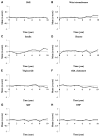Patterns of change in cardiometabolic risk factors associated with the metabolic syndrome among children and adolescents: the Fels Longitudinal Study
- PMID: 19732564
- PMCID: PMC3988693
- DOI: 10.1016/j.jpeds.2009.04.046
Patterns of change in cardiometabolic risk factors associated with the metabolic syndrome among children and adolescents: the Fels Longitudinal Study
Abstract
Objectives: To examine the patterns of change in cardiometabolic risk factors associated with the metabolic syndrome in children and adolescents between the ages of 8 to 19 years.
Study design: Data of children and adolescents who participated in the Fels Longitudinal Study were analyzed. Body mass index, waist circumference, fasting insulin, fasting glucose, triglycerides, high-density lipoprotein cholesterol, systolic blood pressure, and diastolic blood pressure were assessed annually with a standardized protocol.
Results: The proportion of participants having at least 1 change between states of high and normal risk ranged from of 11.0% for body mass index to 30.4% for triglycerides. Youth in the high-risk category at baseline had a higher proportion having changed their status for all risk factors (all P < .05) except waist circumference compared with those in the normal-risk category. There were significant time effects for all risk factors (all P < .01) except fasting glucose and triglyceride levels in metric scores, but insignificant time effects for all risk factors in Z-scores in growth curve analyses.
Conclusions: The cardiometabolic risk factors associated with the MetS were relatively stable among white children and adolescents in the normal risk category. Changes in status were common if the risk factor was elevated.
Figures


Similar articles
-
Compositional analyses of the associations between sedentary time, different intensities of physical activity, and cardiometabolic biomarkers among children and youth from the United States.PLoS One. 2019 Jul 22;14(7):e0220009. doi: 10.1371/journal.pone.0220009. eCollection 2019. PLoS One. 2019. PMID: 31329609 Free PMC article.
-
Longitudinal associations between BMI, waist circumference, and cardiometabolic risk in US youth: monitoring implications.Obesity (Silver Spring). 2013 Mar;21(3):E271-9. doi: 10.1002/oby.20080. Obesity (Silver Spring). 2013. PMID: 23592681 Free PMC article.
-
Waist circumference provides an indication of numerous cardiometabolic risk factors in adults with cerebral palsy.Arch Phys Med Rehabil. 2014 Aug;95(8):1540-6. doi: 10.1016/j.apmr.2014.03.029. Epub 2014 Apr 15. Arch Phys Med Rehabil. 2014. PMID: 24742941
-
Effect of vitamin D supplementation on markers of cardiometabolic risk in children and adolescents: A meta-analysis of randomized clinical trials.Nutr Metab Cardiovasc Dis. 2021 Sep 22;31(10):2800-2814. doi: 10.1016/j.numecd.2021.06.013. Epub 2021 Jun 30. Nutr Metab Cardiovasc Dis. 2021. PMID: 34353700
-
An umbrella review and meta-analysis of meta-analyses of the impact of Ramadan fasting on the metabolic syndrome components.Nutr Rev. 2025 Feb 1;83(2):e711-e721. doi: 10.1093/nutrit/nuae001. Nutr Rev. 2025. PMID: 38335125
Cited by
-
Assessing and Managing the Metabolic Syndrome in Children and Adolescents.Nutrients. 2019 Aug 2;11(8):1788. doi: 10.3390/nu11081788. Nutrients. 2019. PMID: 31382417 Free PMC article. Review.
-
Severity of the metabolic syndrome as a predictor of prediabetes and type 2 diabetes in first degree relatives of type 2 diabetic patients: A 15-year prospective cohort study.World J Diabetes. 2020 May 15;11(5):202-212. doi: 10.4239/wjd.v11.i5.202. World J Diabetes. 2020. PMID: 32477456 Free PMC article.
-
Severity of the metabolic syndrome as a predictor of type 2 diabetes between childhood and adulthood: the Princeton Lipid Research Cohort Study.Diabetologia. 2015 Dec;58(12):2745-52. doi: 10.1007/s00125-015-3759-5. Epub 2015 Sep 17. Diabetologia. 2015. PMID: 26380985 Free PMC article.
-
Childhood metabolic syndrome: must we define it to deal with it?Diabetes Care. 2011 May;34 Suppl 2(Suppl 2):S171-6. doi: 10.2337/dc11-s214. Diabetes Care. 2011. PMID: 21525451 Free PMC article. No abstract available.
-
Development of a metabolic syndrome severity score and its association with incident diabetes in an Asian population-results from a longitudinal cohort in Singapore.Endocrine. 2019 Jul;65(1):73-80. doi: 10.1007/s12020-019-01970-5. Epub 2019 Jun 3. Endocrine. 2019. PMID: 31161560
References
-
- Reaven GM. Banting lecture 1988. Role of insulin resistance in human disease. Diabetes. 1988;37:1595–607. - PubMed
-
- Executive summary of the third report of the National Cholesterol Education Program (NCEP) Expert Panel on Detection, Evaluation, and Treatment of High Blood Cholesterol in Adults (Adult Treatment Panel III) JAMA. 2001;285:2486–97. - PubMed
-
- Goran MI, Ball GD, Cruz ML. Obesity and risk of type 2 diabetes and cardiovascular disease in children and adolescents. J Clin Endocrinol Metab. 2003;88:1417–27. - PubMed
-
- Lawlor DA, Martin RM, Gunnell D, Galobardes B, Ebrahim S, Sandhu J, et al. Association of body mass index measured in childhood, adolescence, and young adulthood with risk of ischemic heart disease and stroke: findings from 3 historical cohort studies. Am J Clin Nutr. 2006;83:767–73. - PubMed
MeSH terms
Substances
Grants and funding
LinkOut - more resources
Full Text Sources
Medical

